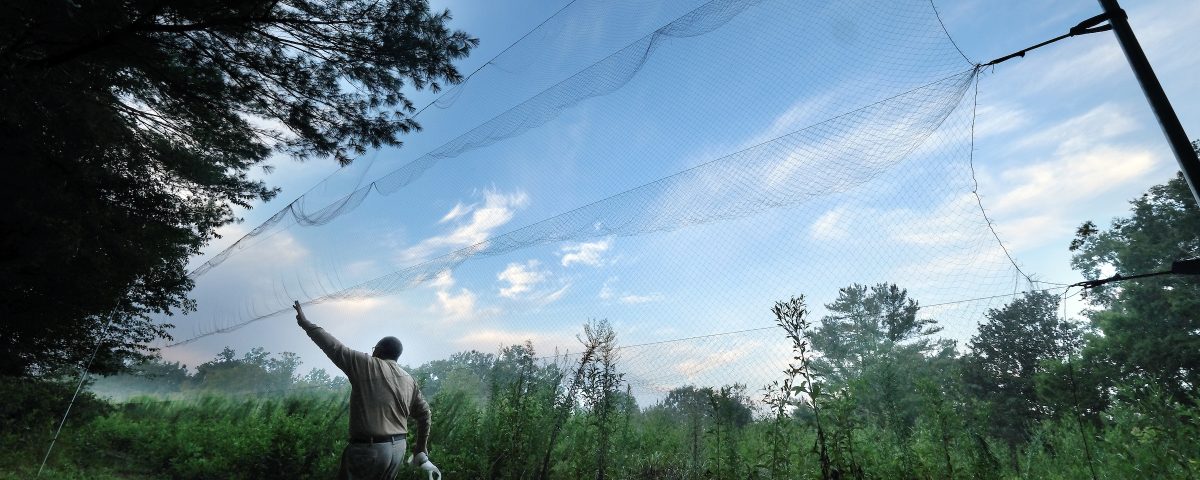Properties conserved by Catawba Lands Conservancy have long served as living laboratories, playing host to a variety of research projects. Previous studies hosted on Conservancy properties have included research on geological formations, monitoring an endangered turtle population and one study (still ongoing) which engages local university students in tracking and assessing native salamander species.
Most recently our team was excited to host a Monitoring Avian Productivity and Survivorship (MAPS) study at Coley Preserve in Lincoln County, N.C. The study, which tracks species of songbirds found at the preserve, has so far yielded 17 different species, including common yellow-throat, white-eyed vireo, Acadian flycatcher and more!
Protocols for the MAPS study are very particular, ensuring that no matter where in the world a birder is working, the data collected about each bird is the same. Each specimen is carefully measured, assessed for breeding condition and sex and banded before being safely released. This allows for comparisons across geographic locations and populations and provides a robust dataset for analysis.
Check out the photos below of the banding process at Coley, and send us any questions you have!
All photos and descriptions by Nancy Pierce.
 The sun has barely risen over CLC’s Coley Preserve as Keith McKenrick sets up 40-foot
The sun has barely risen over CLC’s Coley Preserve as Keith McKenrick sets up 40-foot
pocketed fine nylon nets designed to catch small birds without injuring them.
 As the sun rises and birds venture out of the tall grass and woods,
As the sun rises and birds venture out of the tall grass and woods,
Keith lays out equipment used for gathering data and banding.
 Small songbirds will become agitated if they’re on the ground,
Small songbirds will become agitated if they’re on the ground,
but hanging in the soft net’s pocket this Carolina Wren is docile and calm.
 During extraction, it’s sometimes necessary to make a small cut in the net,
During extraction, it’s sometimes necessary to make a small cut in the net,
which can be repaired. The safety of the bird is always the priority.
 Certified bird banders have been trained how to handle birds without causing injury. Here, Keith
Certified bird banders have been trained how to handle birds without causing injury. Here, Keith
examines this Indigo Bunting’s feather molting patterns to get an idea of its age.
 This Indigo Bunting’s “brood patch” shows that she has bred. The featherless bare
This Indigo Bunting’s “brood patch” shows that she has bred. The featherless bare
spot appears on a mother bird’s underside so she can incubate the eggs and warm her babies.
 Birds remain calm inside hanging linen bags while Keith collects data from other birds.
Birds remain calm inside hanging linen bags while Keith collects data from other birds.
 Besides weight in grams, collected data include: band number, species, sex, age, wing chord length, breeding status,
Besides weight in grams, collected data include: band number, species, sex, age, wing chord length, breeding status,
fat content, date and time of capture, net location and changes in the surrounding habitat since over the year.
 Keith measures the length of the bird’s wing chord (top of the wing).
Keith measures the length of the bird’s wing chord (top of the wing).
 Keith holds the bird with a “banders grip” preparing the band size designated for this species. The band must slide up and down
Keith holds the bird with a “banders grip” preparing the band size designated for this species. The band must slide up and down
easily on the bird’s tarsus (leg) to avoid injury to the bird but not be so big that it catches on underbrush or branches.
 Certified bird banders like Keith send data to the Institute for Bird Populations,
Certified bird banders like Keith send data to the Institute for Bird Populations,
which monitors avian productivity and survivorship, and to a US Geological Services lab.
 The old barn on the Coley Preserve is a backdrop as Keith releases this banded Common Yellowthroat.
The old barn on the Coley Preserve is a backdrop as Keith releases this banded Common Yellowthroat.
 The data are useful even if the banded bird never gets caught by another bander.
The data are useful even if the banded bird never gets caught by another bander.
But in the rare cases where it does, the scientific benefit is more robust.
 Re-bagging the five 40-foot pocketed nets has to be very systematic, to avoid tangling.
Re-bagging the five 40-foot pocketed nets has to be very systematic, to avoid tangling.
 Says Keith: “My favorite part of bird banding is the solitude and having a hands-on experience with nature. But I also like teaching people,
Says Keith: “My favorite part of bird banding is the solitude and having a hands-on experience with nature. But I also like teaching people,
especially children. It brings me joy to see a child’s eyes light up, or to see an adult who has a love for what they see.”




